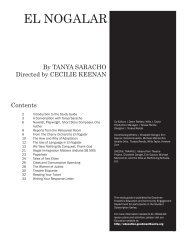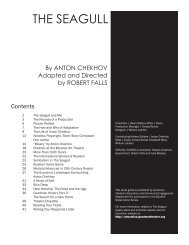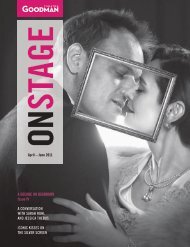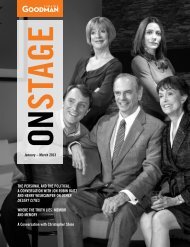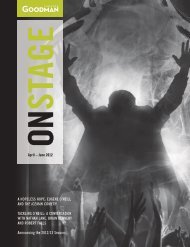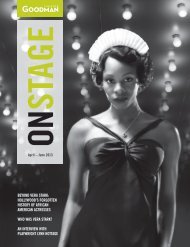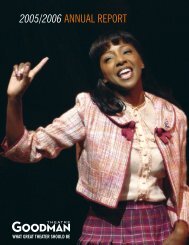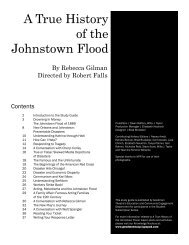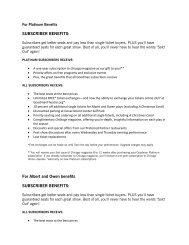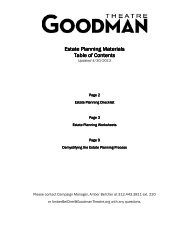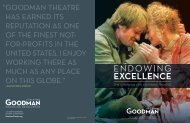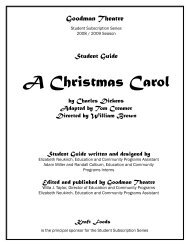A Christmas Carol 2007 Study Guide - Goodman Theatre
A Christmas Carol 2007 Study Guide - Goodman Theatre
A Christmas Carol 2007 Study Guide - Goodman Theatre
You also want an ePaper? Increase the reach of your titles
YUMPU automatically turns print PDFs into web optimized ePapers that Google loves.
cemetery where Tiny Tim is buried. But there are other<br />
places too: the moment of Scrooge’s most intense terror in<br />
the graveyard, when he tries to avoid looking at the grave<br />
and then he finally reads his name.<br />
NE: How did you prepare the text?<br />
PS: During the late summer, early autumn of 1987, I would<br />
work on the text every weekend. Looking back, those were<br />
some of my happiest days. And the more I worked on it, I<br />
felt I could almost feel the characters demanding that I get<br />
on my feet and perform. I found myself wanting to become<br />
the characters—they started<br />
to inhabit me. I put Dickens’<br />
reading version and mine side<br />
by side, and it was a<br />
fascinating study! To have<br />
done mine blind, and then to<br />
see what Dickens did!<br />
Because in so many places<br />
our cuts were identical!<br />
NE: Is there anything<br />
Dickens cut that you left<br />
in?<br />
PS: He changed as the years<br />
went by. What is most<br />
interesting is that he<br />
sentimentalized it; he started<br />
taking out everything that<br />
was hard, dark, grim, or<br />
uncomfortable. […] He was<br />
essentially trying to keep<br />
everything in the first part<br />
frothy, fun, and fantastical so<br />
he could heighten the<br />
dramatic effects in the second<br />
half. To my unimaginable<br />
horror, I discovered that during the last years of his<br />
readings, he never mentioned the two children, Ignorance<br />
and Want.<br />
The Many Faces of Patrick Stewart<br />
Three scenes from Stewart’s one-man version of A <strong>Christmas</strong> <strong>Carol</strong>.<br />
NE: Why is <strong>Carol</strong> so potent? […] is it because Dickens<br />
essentially affirms that redemption is possible? Is<br />
that why we return to this story, for solace?<br />
PS: Well, Dickens wasn’t the first to do this. In many<br />
respects the story is like a lot of late Shakespeare. In the<br />
same way that Shakespeare needed elements such as<br />
magic, ghosts and spirits, and wild coincidence to complete<br />
his fables, so Dickens made the same choice with the<br />
meaning of his story. In The Tempest, and, most potently,<br />
The Winter’s Tale, the heroes are given [whispers] a second<br />
chance! I think we all possess<br />
a very fundamental, ancient<br />
hunger to believe that we can<br />
be saved.<br />
NE: So it’s really about<br />
getting a second chance?<br />
PS: Yes! That’s what’s so<br />
powerful about it! What<br />
happens to Scrooge is not that<br />
he’s told, “You’re going to die,<br />
mate.” It has already<br />
happened! He’s dead! The<br />
grave is already overgrown!<br />
That’s what’s so powerful<br />
about the scene at the<br />
graveyard! That’s why his<br />
waking up at the end is all the<br />
more powerful.<br />
NE: What is the point that<br />
Scrooge finally “gets”?<br />
PS: [Long pause.] He has a<br />
feeling, he has a gentle feeling<br />
about someone else.<br />
NE: He feels tenderness? So the key is that he<br />
empathizes with himself too, and through that feels<br />
for others.<br />
NE: Isn’t that an important moment?<br />
PS: Ahh, it is for me, certainly; it is one of the two or three<br />
critical moments of the whole evening, that moment when<br />
he produces the two children. Because if the audience<br />
doesn’t get that, they won’t get anything I have to say.<br />
NE: So the problem with our understanding of <strong>Carol</strong><br />
is that we focus on Tiny Tim and “God bless us, every<br />
one” and not on the social horrors that Dickens is<br />
trying to expose?<br />
PS: Well, they aren’t seen for very long. One moment<br />
Scrooge is traveling around seeing all these wonderful<br />
<strong>Christmas</strong>es with the Ghost of <strong>Christmas</strong> Present and then<br />
out of nowhere he is confronted by these two—as he calls<br />
them—Monsters. And he asks the question, “Have they no<br />
refuge?” This is a question that he never would have asked<br />
hours earlier.<br />
PS: That’s exactly what he does. He says, “I wish, I wish,”…<br />
and the ghost says, “What?” And Scrooge remembers the<br />
boy he sent away earlier.<br />
NE: Does your audience go out afterward and do<br />
good deeds?<br />
PS: I’m told they do. Joan Rivers came into the dressing<br />
room and said, “I am now going to do the typical Broadway<br />
audience leaving the theater: “Get out of my way. It’s my<br />
taxi!’” Mean, snarling, angry, irritable. Then she said, “I’ve<br />
just come out of the theater, and I’ve seen people say, ‘No,<br />
no, after you. You go first, would you like to share my taxi?’<br />
I heard people say these things, they looked at one another<br />
and smiled as they walked out of your show.”<br />
41<br />
Pictures from www.thepsn.org and www.arts.guardian.co.uk



